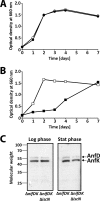Proteome Profiling of the Rhodobacter capsulatus Molybdenum Response Reveals a Role of IscN in Nitrogen Fixation by Fe-Nitrogenase
- PMID: 26644433
- PMCID: PMC4751811
- DOI: 10.1128/JB.00750-15
Proteome Profiling of the Rhodobacter capsulatus Molybdenum Response Reveals a Role of IscN in Nitrogen Fixation by Fe-Nitrogenase
Abstract
Rhodobacter capsulatus is capable of synthesizing two nitrogenases, a molybdenum-dependent nitrogenase and an alternative Mo-free iron-only nitrogenase, enabling this diazotroph to grow with molecular dinitrogen (N2) as the sole nitrogen source. Here, the Mo responses of the wild type and of a mutant lacking ModABC, the high-affinity molybdate transporter, were examined by proteome profiling, Western analysis, epitope tagging, and lacZ reporter fusions. Many Mo-controlled proteins identified in this study have documented or presumed roles in nitrogen fixation, demonstrating the relevance of Mo control in this highly ATP-demanding process. The levels of Mo-nitrogenase, NifHDK, and the Mo storage protein, Mop, increased with increasing Mo concentrations. In contrast, Fe-nitrogenase, AnfHDGK, and ModABC, the Mo transporter, were expressed only under Mo-limiting conditions. IscN was identified as a novel Mo-repressed protein. Mo control of Mop, AnfHDGK, and ModABC corresponded to transcriptional regulation of their genes by the Mo-responsive regulators MopA and MopB. Mo control of NifHDK and IscN appeared to be more complex, involving different posttranscriptional mechanisms. In line with the simultaneous control of IscN and Fe-nitrogenase by Mo, IscN was found to be important for Fe-nitrogenase-dependent diazotrophic growth. The possible role of IscN as an A-type carrier providing Fe-nitrogenase with Fe-S clusters is discussed.
Importance: Biological nitrogen fixation is a central process in the global nitrogen cycle by which the abundant but chemically inert dinitrogen (N2) is reduced to ammonia (NH3), a bioavailable form of nitrogen. Nitrogen reduction is catalyzed by nitrogenases found in diazotrophic bacteria and archaea but not in eukaryotes. All diazotrophs synthesize molybdenum-dependent nitrogenases. In addition, some diazotrophs, including Rhodobacter capsulatus, possess catalytically less efficient alternative Mo-free nitrogenases, whose expression is repressed by Mo. Despite the importance of Mo in biological nitrogen fixation, this is the first study analyzing the proteome-wide Mo response in a diazotroph. IscN was recognized as a novel member of the molybdoproteome in R. capsulatus. It was dispensable for Mo-nitrogenase activity but supported diazotrophic growth under Mo-limiting conditions.
Copyright © 2016, American Society for Microbiology. All Rights Reserved.
Figures




Similar articles
-
NifA is the master regulator of both nitrogenase systems in Rhodobacter capsulatus.Microbiologyopen. 2019 Dec;8(12):e921. doi: 10.1002/mbo3.921. Epub 2019 Aug 22. Microbiologyopen. 2019. PMID: 31441241 Free PMC article.
-
Coordinated expression of fdxD and molybdenum nitrogenase genes promotes nitrogen fixation by Rhodobacter capsulatus in the presence of oxygen.J Bacteriol. 2014 Feb;196(3):633-40. doi: 10.1128/JB.01235-13. Epub 2013 Nov 22. J Bacteriol. 2014. PMID: 24272776 Free PMC article.
-
Coordinated regulation of nitrogen fixation and molybdate transport by molybdenum.Mol Microbiol. 2019 Jan;111(1):17-30. doi: 10.1111/mmi.14152. Epub 2018 Nov 14. Mol Microbiol. 2019. PMID: 30325563 Review.
-
Demonstration of a molybdenum- and vanadium-independent nitrogenase in a nifHDK-deletion mutant of Rhodobacter capsulatus.Eur J Biochem. 1991 Feb 14;195(3):653-61. doi: 10.1111/j.1432-1033.1991.tb15750.x. Eur J Biochem. 1991. PMID: 1999188
-
Nitrogen and molybdenum control of nitrogen fixation in the phototrophic bacterium Rhodobacter capsulatus.Adv Exp Med Biol. 2010;675:49-70. doi: 10.1007/978-1-4419-1528-3_4. Adv Exp Med Biol. 2010. PMID: 20532735 Review.
Cited by
-
Construction of a new T7 promoter compatible Escherichia coli Nissle 1917 strain for recombinant production of heme-dependent proteins.Microb Cell Fact. 2020 Oct 6;19(1):190. doi: 10.1186/s12934-020-01447-5. Microb Cell Fact. 2020. PMID: 33023596 Free PMC article.
-
NifA is the master regulator of both nitrogenase systems in Rhodobacter capsulatus.Microbiologyopen. 2019 Dec;8(12):e921. doi: 10.1002/mbo3.921. Epub 2019 Aug 22. Microbiologyopen. 2019. PMID: 31441241 Free PMC article.
-
Shifting the microbiome of a coral holobiont and improving host physiology by inoculation with a potentially beneficial bacterial consortium.BMC Microbiol. 2021 Apr 28;21(1):130. doi: 10.1186/s12866-021-02167-5. BMC Microbiol. 2021. PMID: 33910503 Free PMC article.
-
A low-potential terminal oxidase associated with the iron-only nitrogenase from the nitrogen-fixing bacterium Azotobacter vinelandii.J Biol Chem. 2019 Jun 14;294(24):9367-9376. doi: 10.1074/jbc.RA118.007285. Epub 2019 May 1. J Biol Chem. 2019. PMID: 31043481 Free PMC article.
-
Comparative differential cuproproteomes of Rhodobacter capsulatus reveal novel copper homeostasis related proteins.Metallomics. 2020 Apr 1;12(4):572-591. doi: 10.1039/c9mt00314b. Epub 2020 Mar 9. Metallomics. 2020. PMID: 32149296 Free PMC article.
References
Publication types
MeSH terms
Substances
LinkOut - more resources
Full Text Sources
Miscellaneous

